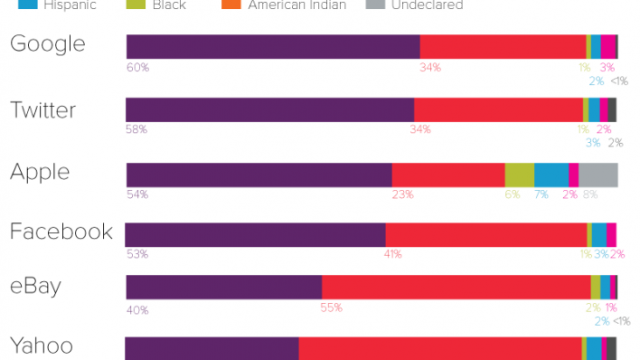The latest hot-button subject in tech, hotter even than ephemeral apps, is diversity. Or at least, if not actual diversity, the act of releasing employee diversity statistics. From Apple to Twitter, almost all the big names in Silicon Valley are doing it. Google fell first in May, and with some pushing by activist organizations the rest soon followed suit.
We’ve broken down some of the top players – Apple, Twitter, Pinterest, Facebook,Google, Yahoo, Microsoft, eBay, LinkedIn, Cisco, Intel, and HP – comparing their overall gender and ethnicity demographics. Then we went a step further to look specifically at the tech and leadership roles. Where relevant, we also charted the demographic information of the U.S. labor force and the graduating computer science class.
Please note that the numbers in the company charts come from a range of sources — federal EEO-1 data, company blog posts, and annual corporate reports. In some cases, particularly diversity in leadership roles, the companies have slight differences in how they collect and categorize their demographic data (For example: counting a global workforce versus just U.S. based).
In other words, it’s not entirely parallel information. But our charts represent the best comparisons we could draw among the companies. When appropriate, we explained the differences in the footnotes.
Based on our research, Amazon, Oracle, and IBM appear to be the last big tech company holdouts for releasing staff demographics. None of them responded to our requests for comment.
Unlike their peers at Twitter and Facebook, these holdouts haven’t had as much pressure placed on them to release their numbers. It looks like the public is far more interested in the companies that capture the most consumer attention; the unsexy, bigger, older corporations are left alone to their own devices.
We spoke with Pinterest engineer Tracy Chou, who some credit as being the first to get the ball rolling on this issue when she published a blog post last October asking “Where are the numbers?” She said that although she’s excited at the transparency shifts, the true work will come in a year’s time.
“It’s ironic when you look at how consumer web companies build their products: You always measure everything in your funnel, you try out new strategies for growth and you measure the metrics. But we weren’t doing any of that with workplace data,” Chou said.
Chou believes there needs to be a “state of the union” every year, where companies release their new staff demographic data. That way, the companies can track which initiatives they’ve implemented to promote diversity are working. And the public can hold them accountable for not just saying they care about staff diversity, but actually doing it.
So without further ado, the numbers:
Overview
High level conclusions: Cisco and Intel lead the pack with the worst gender diversity, 77 percent (Cisco) and 76 percent (Intel) male. That’s kind of impressive in a bad way, given they’re two of the biggest companies in tech with a staff of75,000 and 107,600 employees respectively. eBay is the most gender egalitarian, with women representing 42 percent of employees. Pinterest is second runner up, at 40 percent female.
In terms of ethnic demographics, Pinterest is the least diverse by a slim margin, with 92 percent of the company Asian or white. Google and Facebook trail closely behind, each with 91 percent of the company Asian or white. HP clocks in as the company with the most white people on staff: 71.5 percent. Apple looks to be the most diverse tech company, but as we’ve written about before, that’s because it can include its retail store employees in its data.
As a baseline for comparison, we also pulled the numbers of the U.S. workforce demographics from the Bureau of Labor Statistics (BLS). The U.S. workforce has a much larger swath of white employees than the tech companies. That’s potentially because the BLS doesn’t consider Hispanic or Latino as an ethnicity (which the tech companies did), and it groups Hispanic and Latino people into other races.
Leadership roles

 Leadership demographic data was a particularly tricky one to decipher, so don’t treat the company comparisons as gospel. Some companies count leadership roles as being only vice presidents, others count as broad a definition as “officials and managers.”
Leadership demographic data was a particularly tricky one to decipher, so don’t treat the company comparisons as gospel. Some companies count leadership roles as being only vice presidents, others count as broad a definition as “officials and managers.”
High level conclusions: eBay, Apple, and HP have the most women in leadership roles, although at 28 percent they’re still far from equally weighted. Ebay counted “directors and above” as leaders. HP listed “U.S. officials and managers.” Apple didn’t explain what counted as a “leader” in its blog post, so it could be inflated. Cisco and Pinterest clock as the least egalitarian, with 19 percent of leadership positions filled by women, although Cisco only counts female vice presidents, so that may explain the former’s dismal showing. Pinterest didn’t explain what it counted as “leaders.”
In terms of diversity in leadership roles, HP, Yahoo, and Cisco are the three companies with the most white executives at 80.4 percent, 78 percent, and 76 percent respectively. Yahoo and Cisco define leadership as VPs and above and Facebook didn’t explain what it counted. Apple is by far the most diverse in terms of leadership roles filled with people of different ethnicities, although, once again, without a detailed explanation of who counts as a “leader,” it could have manipulated the definition to make its numbers look good.
Tech roles
Tech companies have both technical and non-technical roles, and the people who occupy the former type of job are notoriously male. The stats prove this out, with Twitter’s technical staff only 10 percent women, and Facebook and Yahoo’s at 15 percent. The other companies fare nearly as badly, with only Pinterest and eBay surpassing the 20 percent mark (at 21 and 24 percent respectively).
 Part of the problem tech companies face in staffing people of diverse ethnicities and gender is that there aren’t enough women or minorities coming down the pipeline from computer science programs. As a base line of comparison, consider the American computer science graduate data for gender: Sure enough, only 14.5 percent of the people graduating with bachelor’s degrees in CS are women. The tech companies are pretty much on par with the graduates.
Part of the problem tech companies face in staffing people of diverse ethnicities and gender is that there aren’t enough women or minorities coming down the pipeline from computer science programs. As a base line of comparison, consider the American computer science graduate data for gender: Sure enough, only 14.5 percent of the people graduating with bachelor’s degrees in CS are women. The tech companies are pretty much on par with the graduates.
In terms of ethnicity breakdown in tech jobs at tech companies, there’s also a heavy emphasis on white and Asian demographics. In technical roles, Apple, once again, has the most diverse staff. The other companies are woefully underrepresented in terms of Hispanic, Black, Native American, multiracial and undeclared.
Strangely enough, the demographic breakdown of ethnicities in tech roles doesn’t mirror graduating computer science students. 60 percent of recent bachelor CS grads were white and only 18 percent Asian. By comparison, for eBay, Yahoo, and LinkedIn, Asian employees actually outnumber the white employees by a sizable margin.







